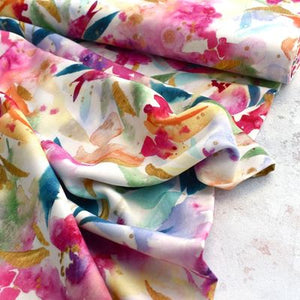It's chilly outside, the rain/snow/wind don't seem to be going anywhere, and your sewing machine is calling your name... Time to take your sewing skills up a notch(ed collar!) and tackle a me-made coat! While this milestone can seem pretty intimidating (So many pieces! So many steps!), sewing your first coat is a satisfying accomplishment that’s more than worth the effort.
When broken down into smaller steps it becomes much more manageable, we promise! And, we are here with some additional guidance and a few insider tips, to help turn this otherwise overwhelming garment from frightening to fashion forward.
1. Don’t Dive Into the Deep End On Your First Go-Round
Since coat construction will likely have you learning new techniques and working with novel tools and notions throughout the process, it’s best to keep things simple. Skip complicated patterns with overly fussy or complicated steps, like shoulder pads or complex tailoring, until you have a bit more coat experience under your belt.

2. Stock Your Toolbox
There are a variety of tools that are typically needed during coat construction that you may or may not already have on-hand. It is always best practice to read your pattern instructions thoroughly to see if the designer recommends any specific tools to make the garment. Some of these may include a particular types of interfacing, heavier weight needles to accommodate thicker materials, a tailoring ham, and clapper.
3. Fabric: Fun and FUNctional
To make the sewing process as stress-free as possible, choose fabrics with a tight weave or knit that aren't going to fray, or if they do, only minimally. These include a variety of wools such as melton, boiled wool, and wool felt. We'd stay away from jacquards, brocades, and loosely woven fabrics that can fray as you handle them. Not a fan of wool? You still have options! Try pre-quilted fabrics, synthetic coatings, fleece, or flannel—all of which will make gorgeous coats without the irritation/itch.

4. Climate Control
If you live in a warmer climate, that doesn’t mean you need to choose between overheating or giving up on your dream coat! Minimize the layers by selecting a coat pattern that is unlined or if it is, select a light weight, airy lining such as bemberg rayon. You can also try sewing up your coat a lighter weight fabric, such as canvas, linen, denim, and cotton twill, to get the look you want without the fear of melting.
5. A Muslin is a Must!
For a project that is as time-intensive as a coat, you definitely want to make sure that you’ve got the right fit! This especially holds true if this is your first time sewing a coat, but is equally valuable if you are working with an unfamiliar pattern or a special fabric you don't want to ruin. There is some good news though! You can often construct your lining and use is as a muslin to check the fit. That saves you from completing an additional time consuming step, and lets you use your toile as part of your finished product!
Sew Smart! Make sure there’s enough ease for whatever you’ll be wearing underneath – don’t just fit the coat to your regular body measurements like you would a shirt or dress!
6. Make Your Mark
Though transferring pattern markings is always recommended and there are a variety of marking tools to choose from, these marks tend to behave more like invisible ink on coating fabrics. Instead, try using tailor’s tacks as markings to guide you. The extra few minutes it takes to sew these simple stitches onto your fabric pieces will likely save you a whole lot of time and energy later on in the project.

7. Length of Stitches = Length of Wear
Working with coating fabrics often means increasing more than your needle size. Since the fabrics used in coat construction are often thicker than those utilized for other garments, a longer stitch length is often necessary to get professional-looking and durable results. Experiment with a variety of stitch lengths on layered scraps of fabric before you start sewing. Be sure to take a photo or make a note of your favorite settings—you won’t regret it!
8. Let Go of Perfection
Life’s too short to stress yourself out over pattern-matching coating fabric. If possibly choose a fabric that doesn't require matching. Or, if you do select fabric with a distinct pattern, such as a plaid or houndstooth, don’t go nuts trying to line every seam up perfectly. Pick one area and one direction to focus your efforts on—we recommend the front pieces and the horizontal direction. That will create the least amount of distraction on the area people usually see first. Don't worry about the side seams or matching up the vertical lines until you have a bit more pattern matching under your belt.
Sew Smart! Rather than trying to pattern-match difficult pieces like the collar, cuffs, or pockets so that they "disappear", cut them on the bias/diagonal and turn them into a design elements. Win, win!
9. Zip It, Zip It Good…or Don’t!
Always remember that one of the biggest perks of taking the time to sew your own clothes is that you have complete creative control! Hate sewing zippers? Close up your coat with some classic toggles instead! Does your pattern call for buttons but arthritis can sometimes make them tricky? Good news - snaps are, well, a snap! Make your garment work for you. Remember, it’s your coat so it’s your choice.

10. RO(S)I: Return On Sewing Investment
Pace yourself. Coat making can seem like a huge undertaking, and you don't need to be rushed. Try to enjoy the process. We know we’ve gone on and on about how long it can take to sew your own coat BUT we promise it will be worth it in the end. This is not a pair of pants that you will likely wear out in a year or two. Instead, the time spent sewing a coat will come back to season after season for many, many years to come.
We SEW Want to Know! What does or would your dream me-made coat look like?







Leave a comment